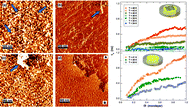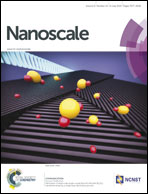Thermolubricity of gas monolayers on graphene
Abstract
Nanofriction of Xe, Kr and N2 monolayers deposited on graphene was explored with a quartz crystal microbalance (QCM) at temperatures between 25 and 50 K. Graphene was grown by chemical vapour deposition and transferred to the QCM electrodes with a polymer stamp. It was found to strongly adhere to the gold electrodes at temperatures as low as 5 K and at frequencies up to 5 MHz. At low temperatures, the Xe monolayers are fully pinned to the graphene surface. Above 30 K, the Xe film slides and the depinning onset coverage beyond which the film starts sliding decreases with temperature. Similar measurements repeated on bare gold show an enhanced slippage of the Xe films and a decrease of the depinning temperature below 25 K. Nanofriction measurements of Kr and N2 confirm this scenario. This thermolubric behaviour is explained in terms of a recent theory of the size dependence of static friction between adsorbed islands and crystalline substrates.


 Please wait while we load your content...
Please wait while we load your content...